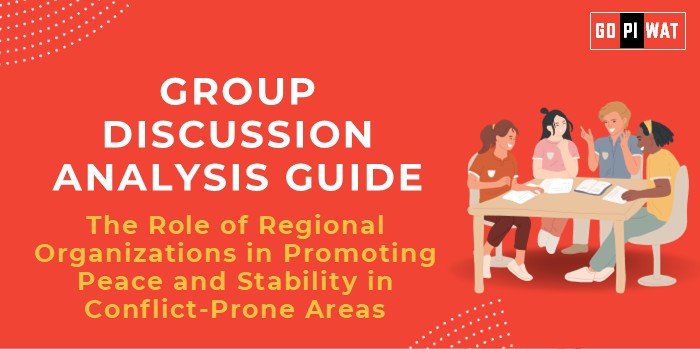📋 Group Discussion (GD) Analysis Guide
🌍 The Role of Regional Organizations in Promoting Peace and Stability in Conflict-Prone Areas
🌟 Introduction to the Topic
Opening Context: Regional organizations like the African Union (AU), European Union (EU), and ASEAN play a pivotal role in conflict resolution, economic collaboration, and political stability across borders. Their role in mitigating regional disputes aligns closely with global goals of peacebuilding.
Topic Background: Historically, regional organizations emerged to address common challenges faced by neighboring nations. For example, the EU evolved post-World War II to ensure lasting peace in Europe. Recent conflicts in regions like Africa, Asia, and the Middle East highlight their role in promoting stability through dialogue, humanitarian aid, and peacekeeping missions.
📊 Quick Facts and Key Statistics
- ✌️ African Union (AU): Conducted 12 peacekeeping missions since its inception.
- 💶 EU’s Peace Efforts: Invested €5 billion annually in conflict resolution programs.
- 🤝 ASEAN’s Role in Rohingya Crisis: Facilitated humanitarian aid for over 700,000 displaced persons.
- 👮 UN Peacekeeping Contributions: Regional organizations provide over 50% of troops.
👥 Stakeholders and Their Roles
- 🏛️ Regional Organizations (AU, EU, ASEAN): Conflict resolution, peacekeeping, economic aid, and diplomatic facilitation.
- 🌍 National Governments: Policy alignment with regional frameworks, troop contributions.
- 📊 International Organizations (UN, World Bank): Funding and technical support.
- ⚖️ Civil Society: Advocacy for transparency and human rights.
🏆 Achievements and Challenges
🌟 Achievements:
- 🛡️ AU Peacekeeping: Successful missions in Somalia reduced extremist activities by 40%.
- 🕊️ EU Mediation in the Balkans: Contributed to stabilizing post-Yugoslav states.
- 🤝 ASEAN Coordination: Established frameworks like the Treaty of Amity and Cooperation to foster peace.
⚠️ Challenges:
- 💰 Funding Limitations: Many organizations face budget deficits, reducing operational efficiency.
- ⚖️ Sovereignty Issues: Member states often resist external intervention.
- 📉 Uneven Regional Capabilities: Variance in political will and resource allocation.
Global Comparisons:
- ✅ Success: NATO’s cohesive response in Kosovo highlights strong defense and diplomacy.
- ❌ Failures: The Arab League’s limited intervention in Syria underscores challenges in unity and authority.
Case Study: Rwanda (1994): Regional inaction demonstrated the necessity for prompt intervention, leading to AU reforms.
✨ Structured Arguments for Discussion
- 💬 Supporting Stance: “Regional organizations amplify localized solutions and bolster global efforts to resolve conflicts effectively.”
- ⚖️ Opposing Stance: “Dependence on regional organizations alone is insufficient due to their limited resources and jurisdictional conflicts.”
- 🔄 Balanced Perspective: “While regional organizations enhance localized conflict resolution, they must operate in synergy with global actors like the UN.”
🎯 Effective Discussion Approaches
- 📖 Opening Approaches:
- “Highlight a successful mission, e.g., AU’s intervention in Somalia.”
- “Contrast achievements with failures, e.g., EU in Ukraine vs. Arab League in Syria.”
- “Use statistics, e.g., troop contributions or aid disbursements.”
- 🔄 Counter-Argument Handling:
- “Acknowledge gaps, e.g., funding.”
- “Offer solutions, e.g., increased international partnerships.”
- “Reinforce with examples of successful collaborations.”
📈 Strategic Analysis (SWOT Framework)
- 💪 Strengths: Regional expertise, cultural understanding, proximity to conflicts.
- ⚠️ Weaknesses: Limited resources, political discord.
- 💡 Opportunities: Partnerships with global agencies, advancing mediation frameworks.
- 🚨 Threats: Escalation of conflicts, erosion of organizational credibility.
📚 Connecting with B-School Applications
- 🌟 Real-World Applications: Project themes on international peace efforts, sustainable development, or trade negotiations.
- 💬 Sample Interview Questions:
- “What lessons can regional organizations learn from NATO’s Kosovo intervention?”
- “How can ASEAN balance diplomacy and non-intervention principles?”
- 📖 Insights for B-School Students:
- Explore global leadership dynamics.
- Analyze public-private collaborations in conflict zones.


